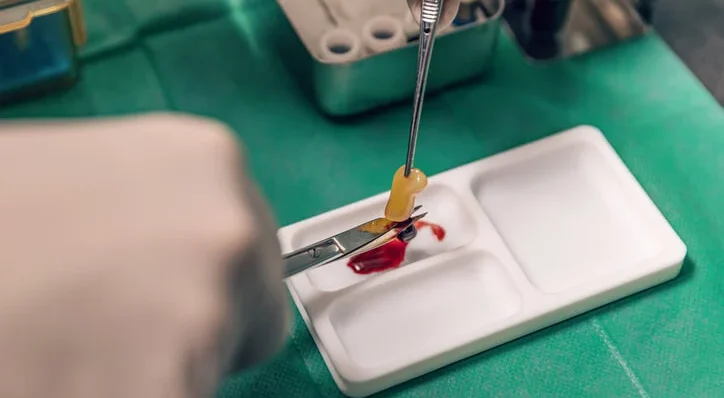Gingival recession, characterized by the apical migration of the gingival margin, is a common dental issue that can lead to root exposure, dentinal hypersensitivity, and aesthetic concerns. Effective management of gingival recession is crucial for both functional and cosmetic reasons. Various treatment modalities have been developed to address this condition, with a focus on promoting root coverage (RC) and improving clinical attachment levels (CAL). One such modality is the use of platelet-rich fibrin (PRF), which has gained attention for its potential to enhance healing and regeneration in periodontal procedures. This systematic review and meta-analysis aimed to compare the effectiveness of PRF with other widely used treatment approaches in root coverage procedures.
Materials and Methods
The review focused on randomized controlled trials (RCTs) that compared the performance of PRF with other treatment modalities in managing Miller Class I or II (Cairo RT I) gingival recessions. The eligibility criteria for the included studies were stringent, ensuring that only high-quality RCTs were considered. These studies were categorized into five distinct groups for comparison:
- Coronally advanced flap (CAF) alone versus CAF combined with PRF (CAF/PRF).
- CAF combined with connective tissue graft (CAF/CTG) versus CAF/PRF.
- CAF combined with enamel matrix derivative (CAF/EMD) versus CAF/PRF.
- CAF combined with amnion membrane (CAF/AM) versus CAF/PRF.
- CAF/CTG versus CAF combined with both CTG and PRF (CAF/CTG/PRF).
The primary outcome measured was the percentage of relative root coverage (rRC), while secondary outcomes included clinical attachment level (CAL), keratinized mucosa width (KMW), and probing depth (PD).
Results
Out of 976 articles initially identified, 17 RCTs met the inclusion criteria and were analyzed. The findings revealed that the use of PRF in conjunction with CAF resulted in a statistically significant increase in rRC and CAL compared to CAF alone. However, no significant changes were observed in KMW or PD. When comparing CAF/PRF with CAF/CTG, the latter demonstrated significantly better outcomes in terms of KMW and RC, indicating that CTG remains a superior option in these aspects.
Furthermore, no significant differences were found between the CAF/PRF and CAF/EMD groups or between the CAF/PRF and CAF/AM groups regarding any of the evaluated parameters. This suggests that PRF offers comparable results to EMD and AM when used alongside CAF, but without offering any additional benefits in the measured outcomes.
Discussion
The results of this meta-analysis underscore the potential of PRF as a valuable adjunct in the treatment of gingival recessions. The significant improvement in rRC and CAL when PRF is used with CAF compared to CAF alone highlights PRF’s role in enhancing periodontal regeneration. The ability of PRF to stimulate healing and provide a scaffold for tissue regeneration may explain these benefits.
However, the findings also indicate that PRF does not contribute to an increase in KMW, which is a critical factor in ensuring long-term stability and resistance to further recession. In this regard, CTG continues to be the gold standard, particularly in cases where an increase in KMW is desired. The superiority of CTG in achieving better KMW and RC suggests that it remains the preferred treatment, especially in patients with limited baseline KMW.
On the other hand, the lack of significant differences between CAF/PRF and CAF/EMD or CAF/AM groups suggests that PRF might offer a cost-effective alternative to these materials without compromising clinical outcomes. This could be particularly beneficial in situations where access to EMD or AM is limited or where cost considerations play a significant role in treatment planning.
Conclusion
The use of PRF in conjunction with CAF significantly improves root coverage and clinical attachment levels compared to CAF alone, making it a viable option for treating gingival recessions. However, when the goal is to increase keratinized mucosa width, CTG should be favored over PRF due to its superior performance in this aspect. While PRF does not enhance KMW, its comparable outcomes with EMD and AM suggest it as an alternative in specific clinical scenarios. Overall, PRF represents a promising adjunct in periodontal therapy, particularly in cases where enhancing root coverage and clinical attachment are the primary objectives.
Clinical Relevance
This review provides clinicians with valuable insights into the role of PRF in managing gingival recessions. While PRF offers significant benefits in improving root coverage and clinical attachment, its limitations in increasing KMW highlight the continued importance of CTG in comprehensive periodontal treatment planning. In cases where baseline KMW is limited, CTG should be prioritized to achieve optimal long-term results.
Source: Pubmed

